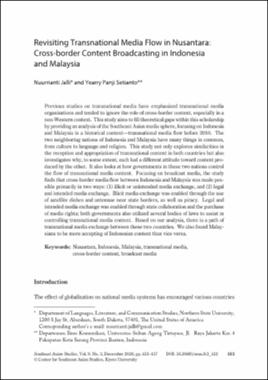| dc.contributor.author | Jalli, Nuurrianti | |
| dc.contributor.author | Setianto, Yearry Panji | |
| dc.date.accessioned | 2023-09-12T19:58:23Z | |
| dc.date.available | 2023-09-12T19:58:23Z | |
| dc.date.issued | 2020-12-01 | |
| dc.identifier | oksd_jalli_revisiting_transnational_media_flow_2020 | |
| dc.identifier.citation | Jalli, N., Setianto, Y.P. (2020). Revisiting transnational media flow in Nusantara: cross-border content broadcasting in Indonesia and Malaysia. Southeast Asian Studies, 9(3), pp. 413-437. https://doi.org/10.20495/seas.9.3_413 | |
| dc.identifier.uri | https://hdl.handle.net/11244/339568 | |
| dc.description.abstract | Previous studies on transnational media have emphasized transnational media organizations and tended to ignore the role of cross-border content, especially in a non-Western context. This study aims to fill theoretical gaps within this scholarship by providing an analysis of the Southeast Asian media sphere, focusing on Indonesia and Malaysia in a historical context—transnational media flow before 2010. The two neighboring nations of Indonesia and Malaysia have many things in common, from culture to language and religion. This study not only explores similarities in the reception and appropriation of transnational content in both countries but also investigates why, to some extent, each had a different attitude toward content produced by the other. It also looks at how governments in these two nations control the flow of transnational media content. Focusing on broadcast media, the study finds that cross-border media flow between Indonesia and Malaysia was made possible primarily in two ways: (1) illicit or unintended media exchange, and (2) legal and intended media exchange. Illicit media exchange was enabled through the use of satellite dishes and antennae near state borders, as well as piracy. Legal and intended media exchange was enabled through state collaboration and the purchase of media rights; both governments also utilized several bodies of laws to assist in controlling transnational media content. Based on our analysis, there is a path of transnational media exchange between these two countries. We also | |
| dc.format | application/pdf | |
| dc.language | en_US | |
| dc.publisher | Center for Southeast Asian Studies, Kyoto University | |
| dc.relation.ispartof | Southeast Asian Studies, 9 (3) | |
| dc.relation.uri | https://www.jstage.jst.go.jp/article/seas/9/3/9_413/_pdf | |
| dc.rights | This material has been previously published. In the Oklahoma State University Library's institutional repository this version is made available through the open access principles and the terms of agreement/consent between the author(s) and the publisher. The permission policy on the use, reproduction or distribution of the material falls under fair use for educational, scholarship, and research purposes. Contact Digital Resources and Discovery Services at lib-dls@okstate.edu or 405-744-9161 for further information. | |
| dc.title | Revisiting transnational media flow in Nusantara: cross-border content broadcasting in Indonesia and Malaysia | |
| dc.date.updated | 2023-09-08T22:13:13Z | |
| osu.filename | oksd_jalli_revisiting_transnational_media_flow_2020.pdf | |
| dc.description.peerreview | Peer reviewed | |
| dc.identifier.doi | 10.20495/seas.9.3_413 | |
| dc.description.department | Media and Strategic Communications | |
| dc.type.genre | Article | |
| dc.type.material | Text | |
| dc.subject.keywords | Nusantara | |
| dc.subject.keywords | transnational media | |
| dc.subject.keywords | cross-border content | |
| dc.subject.keywords | broadcast media | |
| dc.subject.keywords | Indonesia | |
| dc.subject.keywords | Malaysia | |
| dc.identifier.author | ORCID: 0000-0001-5680-5682 (Jalli, Nuurrianti) | |
